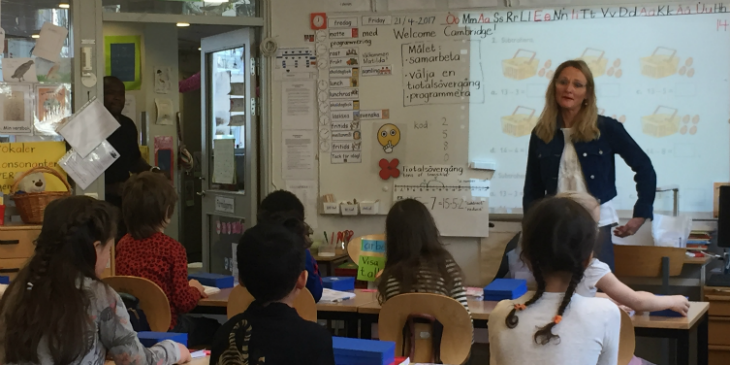One of the joys of working on the Cambridge Maths project is the opportunity to visit other jurisdictions. The latest trip took the writing team to Scandinavia for two weeks of conversations, school visits and couple of conferences, and we’re just beginning to distill the masses of information we collected into readings, research and actions that we can learn from.
Of course it’s very easy to think of all the countries of the Scandinavian peninsula as similar, just as, I suppose, others might consider the countries of the British Isles as the same. And of course they are all distinct, having different histories, languages and cultures. However for the purposes of this first blog, I’m going to consider those specific aspects of the education system which do seem to be common to the three countries we visited; Sweden, Norway and Finland.
The system
Most schools are state schools with a very small number of private schools. Private schools are still funded largely by the government but can only be set up for a reason – for example a distinct pedagogy or religion. They are independent in terms of their philosophy and how they arrange the learning and teaching but do have to follow the national curriculum.
Children start formal school at around 7, with earlier child care available and free for all, and a bridging class between kindergarten and formal school. In all systems students are given choices at 16 but up until then everyone follows the same curriculum. All classes are mixed ability and setting by ability is not allowed by law, although teachers are expected to differentiate for individual need within a class. Only those who have exceptional special needs are catered for separately.
The atmosphere in schools feels informal. Teachers are called by their first names and dress is casual with no school uniforms. All students eat school lunches which are provided free. Depending on the geographical district, schools are more or less open to the public to wander through – there is very little security evident.
Students are graded at least yearly by their teachers and these grades are seen as very important. Formal assessment happens at 16 and then later, with some other intermediate assessments, for example at grades 3,6,9, used by the state to gauge the national standards. These intermediate ones are not statutory. Most public assessments are marked by the teachers themselves and are triangulated by others.
In the classroom

The classes we saw had around 20-25 students and this seems to be the norm, as was the presence of teacher assistants. Teachers have a great deal of discretion about how they teach, and in schools where there are several classes of the same age, teachers plan and sometimes teach together. Curriculum content is given for two or more years at a time and teachers decide in what order to teach. The curriculum states the knowledge and general requirements but any pedagogical content is advisory only. Teachers choose from a range of resources and text books, none of which are statutory. All teachers specialize in their training and teach more than one subject, though only those working with the youngest children are expected to teach across the whole subject range.
In talking about our visit, though, we were struck by some underlying feeling/philosophy/way of behaving that was difficult to name. This was evident in the actions which placed a heavy emphasis on both individual and social responsibility. When we talked with teachers and policy makers about early years education, for example, it was clear that the focus was on the whole child – ‘educare’ as they called it. This meant caring and nurturing the child’s physical and mental needs in a learning atmosphere where play, creativity and enjoyment were seen as incredibly important. In primary classes teachers told us that they had two aims - supporting their students to be independent whilst caring for and working with other students in their class, and learning some mathematics. These aims were equally important. In the secondary classroom we visited, the head teacher told us how they were working together with the students to take care of their physical and mental needs. In all cases there was a deep mutual trust between teachers, parents and students.
These ideas of holistic education, everyone being equally important and taking care of each other, are perhaps encapsulated in Janteloven (the law of Jante). At its simplest it describes the way that all Scandinavians should behave: putting society ahead of the individual, and not boasting about individual accomplishments or being jealous of others. This means that whilst PISA results and the like are considered to have an important role in reflecting on the success of the education system, they do not determine a volte-face in policy. Now that’s something we could learn from….